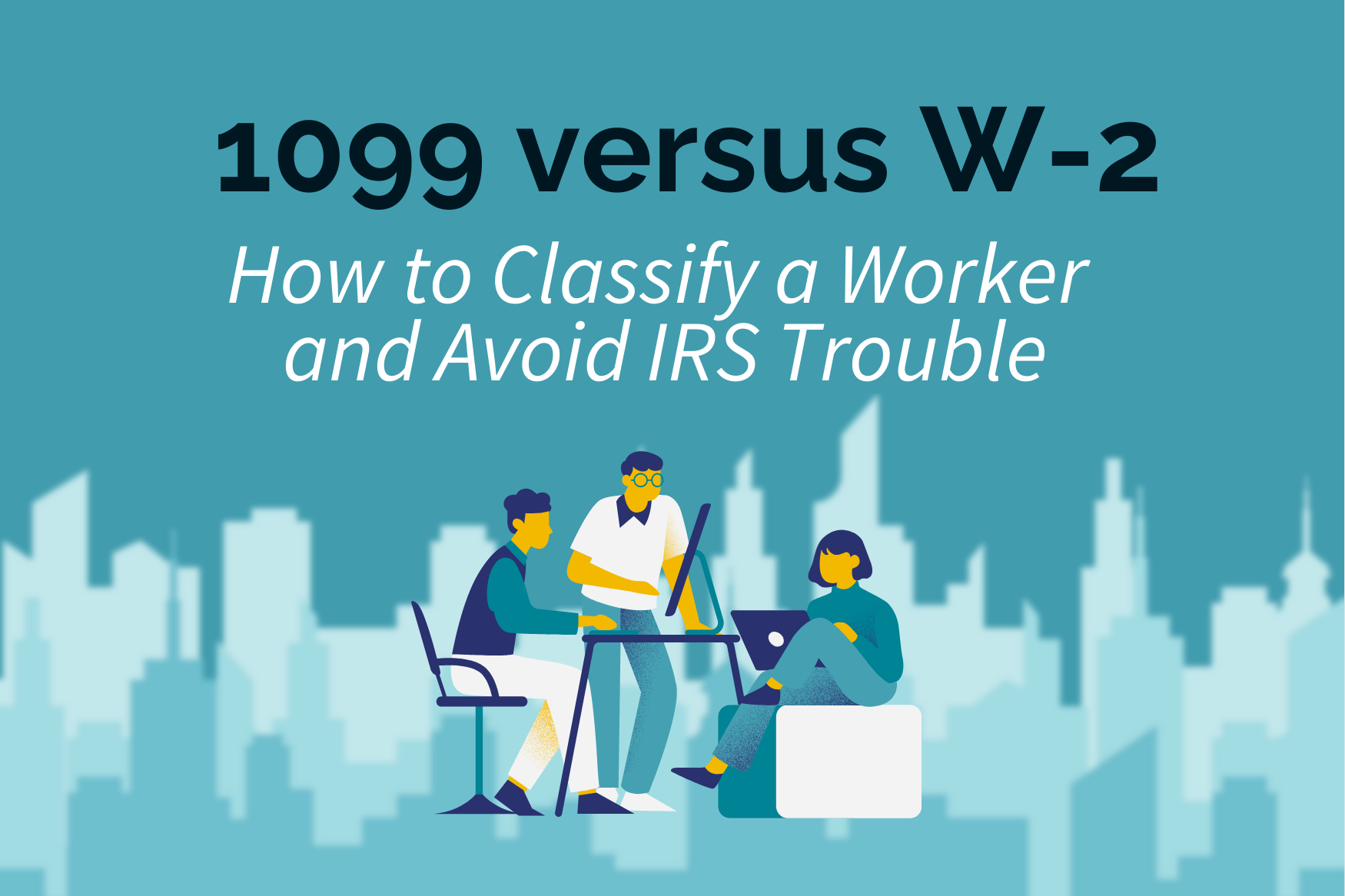Quick Answer:
A W-2 employee is on your payroll, with taxes withheld, employer benefits, and controlled work hours and methods. A 1099 contractor is self-employed, controls how and when work is done, uses their own tools, and pays their own taxes.
Misclassifying can lead to IRS audits, back taxes, fines, and legal fees.
Why This Matters (as of 2025)
With the U.S. gig economy surpassing 70 million freelance workers (U.S. Census Bureau), more companies are blending W-2 employees and 1099 contractors to:
- Fill skill gaps quickly
- Test new roles without permanent headcount
- Scale up or down with market conditions
But as laws like California’s AB-5 and the U.S. Department of Labor’s 6-factor test gain traction, misclassification risks—and penalties—are increasing (ADP).
W-2 vs. 1099: Classification Checklist
If most answers fall in the left column, likely W-2. If in the right column, likely 1099.
| Sounds Like W-2 If… | Sounds Like 1099 If… |
|---|---|
| You dictate how work is done | You only care about the end result |
| You set work hours | They set their own schedule |
| They use your tools | They use their own tools |
| They work only for you | They have multiple clients |
| You provide ongoing training | They start with minimal onboarding |
Examples to Make It Clear
✅ Hire a 1099 for a 6-week website rebuild—no matter where they work from.
❌ Don’t call someone a 1099 if they sit in your office 9–5 using your laptop.
✅ Hire a W-2 for a customer service rep who must be logged in during business hours.
❌ Don’t label your marketing manager a contractor while giving them the same oversight as staff.
Roles Most Often Misclassified
(High risk of audit if treated as 1099)
- Administrative Assistants
- Marketing/Social Media Managers
- Project Managers
- Customer Support Representatives
- Bookkeepers / Junior Accountants
💡 Rule of Thumb: If you’d panic if they didn’t log in at 9:00 AM, they’re probably a W-2.

The Cost of Getting It Wrong
Misclassifying a worker isn’t just a paperwork oops—it’s a financial, legal, and reputational landmine.
Here’s what’s at stake:
1. Back Payroll Taxes + Interest
When a contractor is reclassified as a W-2 employee, you may owe both the employer and employee portions of Social Security and Medicare taxes, plus federal and state unemployment taxes. These are calculated retroactively, often going back several years.
Add interest (currently 4–6% annually) and the total balloons quickly.
Example: For a $60K/year worker, employer payroll taxes alone can exceed $4,500/year, before interest.
2. Federal & State Fines
The IRS can issue penalties for failing to withhold taxes, file correct forms, and pay on time.
Failure-to-pay penalty: 0.5% per month until paid.
States may impose additional fines, especially in states with aggressive enforcement like California, New York, and Massachusetts.Failure-to-file penalty: 5% of unpaid taxes for each month late, up to 25%.
3. Owed Benefits & Overtime Pay
Benefit: An HR manager’s ability to smoothly transition the workforce through changes while maintaining clear communication will help with a misclassified worker should have been an employee, you could be on the hook for:
Health insurance premiums
Retirement plan contributions (401k match, pensions)
Paid time off accruals
Overtime wages under the Fair Labor Standards Act (FLSA)
In some cases, courts have ordered employers to reimburse years of lost benefits, multiplying the cost.
4. Legal Fees & Settlements
Misclassification cases often trigger lawsuits, sometimes as class actions if multiple workers are affected. Even if you settle, legal fees for defense can easily reach five to six figures.
Many states allow workers to recover attorneys’ fees, meaning you could be paying both sides’ lawyers.
5. Brand & Reputation Damage
While harder to quantify, the reputational hit from a publicized misclassification dispute can hurt recruitment, client trust, and investor confidence. For small businesses, the damage can be lasting.
Real-World Impact:
The Forbes Business Council notes that a $60K/year misclassified contractor could cost an employer $10K–$20K+ in back taxes, penalties, and benefits. Add legal fees or multiple employees, and the numbers escalate into the hundreds of thousands.
When 1099 Isn’t an Option: Flexible Alternatives
Sometimes, the work arrangement you have in mind doesn’t meet the legal definition of an independent contractor—no matter how much flexibility you want. But that doesn’t mean you’re locked into a traditional, long-term W-2 hire. There are several compliance-friendly hiring models that give you agility without the legal risk.

1. Contingent Hire
A contingent hire is a short-term W-2 employee with a clearly defined start and end date.
Example: Hiring a marketing coordinator from September through December to execute a holiday campaign.
Best for: Project-based roles, seasonal spikes, or covering temporary gaps like parental leave.
How it works: The worker is on your payroll, you handle taxes and benefits as required, and both sides know the role ends on a set date.
Why it’s great: You stay compliant with employment laws, while avoiding the long-term cost of adding permanent headcount.
2. Temp-to-Perm
The temp-to-perm model lets you “try before you buy” while a staffing agency serves as the employer of record.
Example: Bringing on a customer success specialist for a 90-day trial period before offering them a permanent position.
Best for: Roles where you’re uncertain about long-term fit or budget commitment.
How it works: The staffing agency handles payroll, benefits, and compliance for the temporary period. If things go well, you convert the person to your payroll after a set timeframe.
Why it’s great: Reduces your risk and onboarding time while ensuring compliance from day one.
3. Retainer-Based Engagement
A retainer-based arrangement is perfect when you need ongoing access to specialized skills without a full-time hire.
Example: Keeping a copywriter on retainer for 20 hours per month to handle blog posts, newsletters, and website updates.
Best for: Highly skilled specialists such as designers, consultants, or technical advisors.
How it works: You agree to pay for a set number of hours or deliverables each month. The engagement is structured as a vendor relationship, and the contractor must truly meet 1099 criteria (e.g., multiple clients, their own tools, control over how they work).
Why it’s great: Predictable costs, flexible access to expertise, and no need for constant sourcing.
Pro Tip: If your “retainer” is essentially someone working regular hours, reporting to a manager, and using your systems exclusively—it’s not a retainer; it’s a misclassified employee. Always structure these agreements with compliance in mind.
Key Takeaways
- W-2 = employer control, payroll taxes withheld, benefits
- 1099 = self-employed, independent work, no payroll withholding
- Misclassification = financial and legal risk
- Laws are tightening—review classification before hiring
- Boulo Solutions helps you classify, source, and onboard the right way
FAQ: W-2 vs. 1099 Classification
How do I know if a worker should be a W-2 or 1099?
If you control how and when the work is done, supply tools, require set hours, and provide ongoing training, they’re likely a W-2 employee. If they control their own schedule, use their own tools, and work for multiple clients, they’re likely a 1099 contractor. Always verify against IRS and Department of Labor guidelines before hiring.
What happens if I misclassify an employee as a contractor?
You could owe back payroll taxes, penalties, interest, owed benefits, and legal fees. Misclassification can also trigger state-level fines and damage your brand reputation. In some cases, the total cost can reach tens of thousands of dollars per worker.
Are there jobs that are almost always W-2?
Yes. Roles with set schedules, ongoing oversight, and embedded team workflows—such as administrative assistants, customer service reps, and marketing managers—are typically W-2 positions.

Can I switch a contractor to an employee later?
Absolutely. Many companies start with a 1099 contractor to test a role or skill set, then convert to W-2 once they confirm ongoing need. Models like temp-to-perm or contingent hire make this transition smooth and compliant.
Is hiring a 1099 contractor cheaper than a W-2 employee?
Not always. While 1099 contractors don’t require payroll taxes or benefits, their hourly rate is often higher. The real savings come from flexibility—being able to hire only for specific projects or timeframes.
Where can I find the official rules for worker classification?
Start with the IRS Independent Contractor Test and the U.S. Department of Labor’s Economic Reality Test. State-specific laws, like California’s AB-5, may add additional requirements.
How can Boulo Solutions help with W-2 vs. 1099 decisions?
Boulo Solutions reviews your role requirements, applies classification rules, sources the right talent, and manages onboarding—so you stay compliant and avoid costly mistakes.
The Bottom Line
Classifying workers correctly isn’t just about avoiding an IRS letter in your mailbox—it’s about protecting your business, your people, and your peace of mind. The difference between a W-2 and a 1099 comes down to control, independence, and compliance—and getting it wrong can cost you far more than payroll taxes.
The good news? You don’t have to figure it out alone. Whether you need a full-time W-2 hire, a true 1099 contractor, or a creative, compliant middle ground like contingent or temp-to-perm, Boulo Solutions can help you:
- Decide with confidence using clear, compliant criteria.
- Source top talent that meets your exact needs.
- Onboard smoothly so everyone knows the expectations from day one.
Hiring should feel exciting—not risky. Let’s make sure your next hire is set up for success, for you and for them.
Simplify your hiring journey—explore Boulo today to discover how we can connect you with the ideal candidate, meeting your business goals and saving you time!

